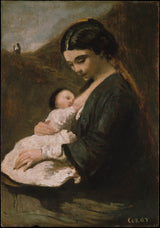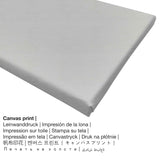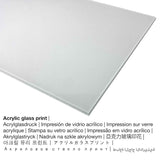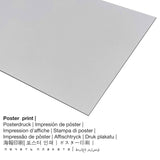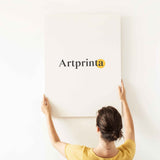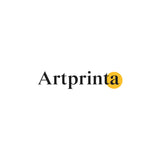Camille Corot, 1860 - Nne na Nwa - mbipụta nka mara mma
Ụtụ gụnyere. Mbupu gbakọrọ na ndenye ọpụpụ.
Kedu ihe ga-amasị gị ngwaahịa ngwaahịa?
Anyị na-enye ụdị nha na ihe dị iche iche maka ngwaahịa ọ bụla. Họrọ nha na ihe kacha amasị gị n'ime nhọrọ ndị a:
- Aluminom dibond mbipụta (ọla): Aluminium Dibond prints are prints on metal with an impressive depth. The Aluminium Dibond Print is your perfect introduction to fine art reproductions on aluminum. For the Aluminium Dibond print, we print your chosen artpiece right on the surface of the white-primed aluminum material. The bright & white components of the work of art shimmer with a silky gloss but without any glow. This print on aluminium is one of the most popular entry-level products and is an extremely contemporary way to display artworks, because it draws focus on the replica of the artwork.
- Poster (akwa akwa akwa): Our poster is a printed flat canvas paper with a slight finish on the surface. Please bear in mind, that depending on the size of the canvas poster print we add a white margin of something between 2-6 cm around the work of art, which facilitates the framing with your custom frame.
- Mbipụta kanvas: A canvas print is a printed cotton canvas mounted on a wood frame. It generates the plastic impression of three dimensionality. Canvas Prints have the advantage of being low in weight, which means that it is quite simple to hang your Canvas print without any wall-mounts. Therefore, canvas prints are suited for all types of walls.
- Mbipụta enyo acrylic: A glossy acrylic glass print, which is often described as a plexiglass print, will change an original into wall décor and forms a distinct alternative option to dibond or canvas prints. Your own version of the work of art is printed with modern UV printing technology.
Ederede iwu: We try to describe our art products as closely as possible and to illustrate them visually in our shop. Nevertheless, the pigments of the print materials, as well as the printing can vary somehwat from the presentation on your screen. Depending on the screen settings and the nature of the surface, not all color pigments will be printed 100% realistically. Because all the are processed and printed by hand, there might as well be minor deviations in the motif's exact position and the size.
Nkọwapụta nka nka mbụ dị ka e si na The Metropolitan Museum of Art nyere (© - Ụlọ ihe ngosi nka nke obodo ukwu - Museumlọ ihe ngosi nka nke Obodo)
This small panel, probably done in the 1860s, was evidently well known and admired in Corot's circle of friends. Both Constant Dutilleux (1807–1865) and Charles Desavary (1837–1885), two painters living in Arras, a town in northern France that Corot often visited, copied the painting. About 1873 Corot gave it to his patron Cléophas, who had provided him with a supplementary studio where he could work undisturbed.
a 19th narị afọ ọrụ nka mere site na onye n’ezie artist Camille Corot in 1860. The 160 nka nka dị afọ nwere nha ndị a: 12 3/4 x 8 7/8 na (32,4 x 22,5 cm) and was painted on the medium oil on wood. What is more, this artpiece belongs to the The Metropolitan Museum of Art's art collection in New York City, New York, United States of America. With courtesy of: The Metropolitan Museum of Art, New York, H. O. Havemeyer Collection, Gift of Mrs. P. H. B. Frelinghuysen, 1930 (license: public domain). The creditline of the artwork is: H. O. Havemeyer Collection, Gift of Mrs. P. H. B. Frelinghuysen, 1930. Ọzọkwa, alignment bụ Eserese ma nwee oke akụkụ nke 1: 1.4, nke pụtara na ogologo bụ 29% mkpụmkpụ karịa obosara. The painter Camille Corot was an artist from France, whose style was primarily Realism. The artist was born in 1796 and died at the age of 79 n'afọ 1875.
Tebụl nka nka
| Aha nke eserese ahụ: | "Nne na Nwa" |
| Nhazi nke ihe nka: | sere |
| Otu sara mbara: | nkà nke oge a |
| Nhazi oge: | 19th narị afọ |
| Emepụtara na: | 1860 |
| Afọ nka: | ihe karịrị 160 afọ |
| Ọkara nke ihe osise izizi: | mmanụ n'elu osisi |
| Nha nke ihe osise izizi: | 12 3/4 x 8 7/8 na (32,4 x 22,5 cm) |
| Ụlọ ihe ngosi nka / ebe: | Museumlọ ihe ngosi nka nke Obodo |
| Ebe ngosi nka: | New York City, New York, Njikota Obodo Amerika |
| Ebe nrụọrụ weebụ ihe ngosi nka: | Museumlọ ihe ngosi nka nke Obodo |
| Ụdị nka nka: | ngalaba ọha |
| Site n'aka: | The Metropolitan Museum of Art, New York, H. O. Havemeyer Collection, Gift of Mrs. P. H. B. Frelinghuysen, 1930 |
| Ebe E Si Nweta: | H. O. Havemeyer Collection, Gift of Mrs. P. H. B. Frelinghuysen, 1930 |
Nkọwa ngwaahịa ahaziri ahazi
| Ụdị edemede: | ọrụ mgbidi |
| Usoro mmeghari: | dijitalụ mmeputakwa |
| Usoro mmepụta: | Mbipụta UV ozugbo (mbipụta dijitalụ) |
| Nlụpụta: | Germany |
| Ụdị ngwaahịa: | a na-achọ |
| Ihe eji eme atụmatụ: | nka mgbidi, gallery mgbidi |
| Ntuziaka onyonyo: | nhazi ihe osise |
| Njikwa oyiyi: | 1: 1.4 |
| Mmetụta ihe onyonyo: | ogologo bụ 29% mkpụmkpụ karịa obosara |
| Akwa ngwaahịa dị: | Mbipụta kwaaji, mbipụta enyo acrylic (nwere ezigbo mkpuchi iko), mbipụta akwụkwọ mmado (akwụkwọ kwaaji), mbipụta ọla (aluminium dibbond) |
| Ọdịiche dị n'okirikiri akwa akwa akwa (akwa akwa): | 50x70cm - 20x28", 100x140cm - 39x55" |
| Mpempe iko acrylic (nwere ezigbo mkpuchi iko) nha: | 50x70cm - 20x28", 100x140cm - 39x55" |
| Mpempe akwụkwọ mmado (akwụkwọ kwaaji) nha: | 50x70cm - 20x28" |
| Mpempe akwụkwọ Dibony (ihe alumnium) nha: | 50x70cm - 20x28", 100x140cm - 39x55" |
| Igwe onyonyo: | agunyeghi |
Banyere omenka
| Aha onye nka: | Camille Corot |
| okike onye nka: | nwoke |
| Obodo onye nka: | French |
| Ọrụ nke onye na-ese ihe: | onye na-ese ihe |
| Obodo onye nka: | France |
| Nhazi nke onye nka: | omenkà nke oge a |
| Ụdị nka: | Ihe ngosi |
| Oge ndu: | 79 afọ |
| Afọ ọmụmụ: | 1796 |
| Afọ nwụrụ: | 1875 |
© nwebiisinka site na - Artprinta (www.artprinta.com)

